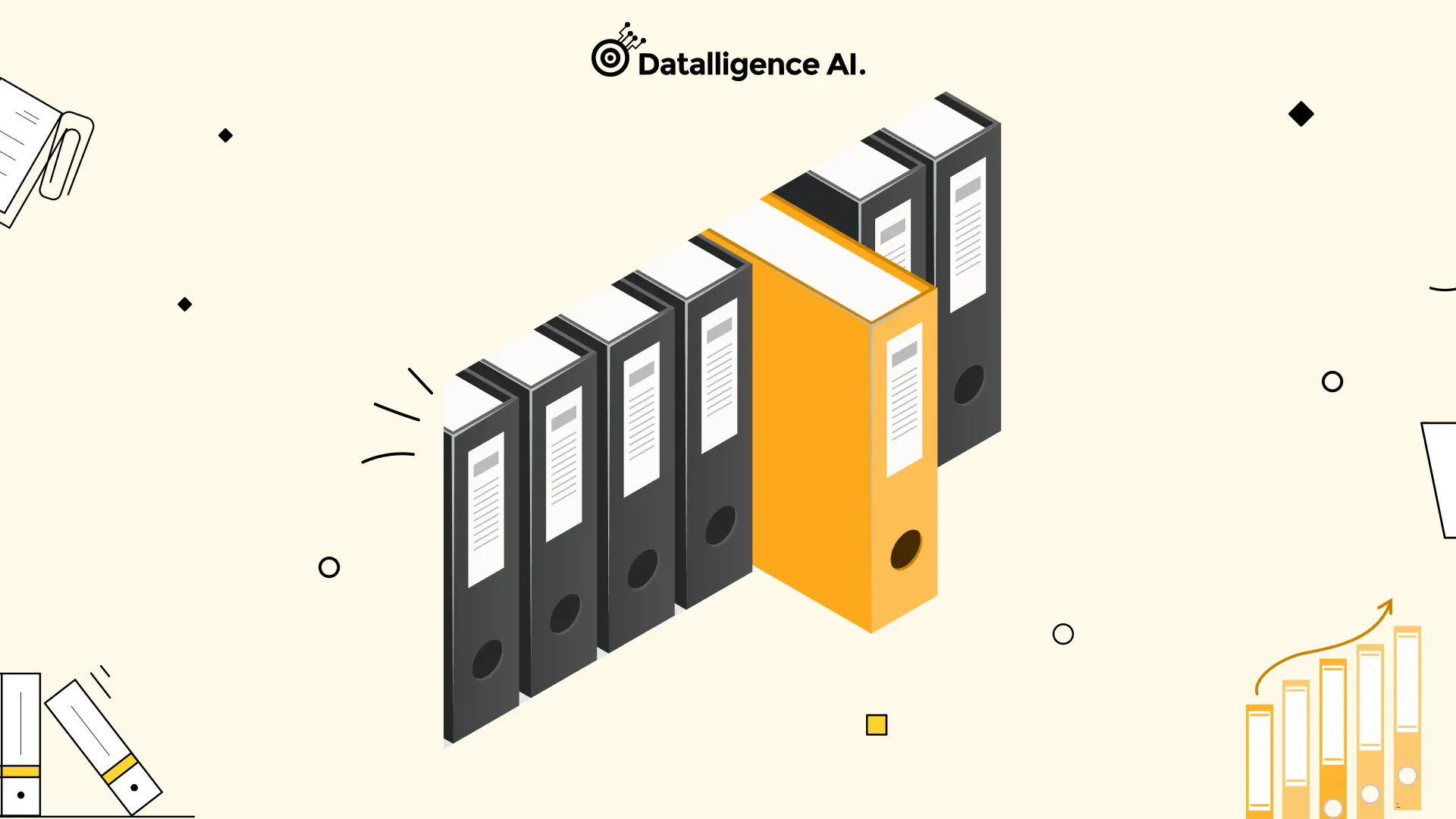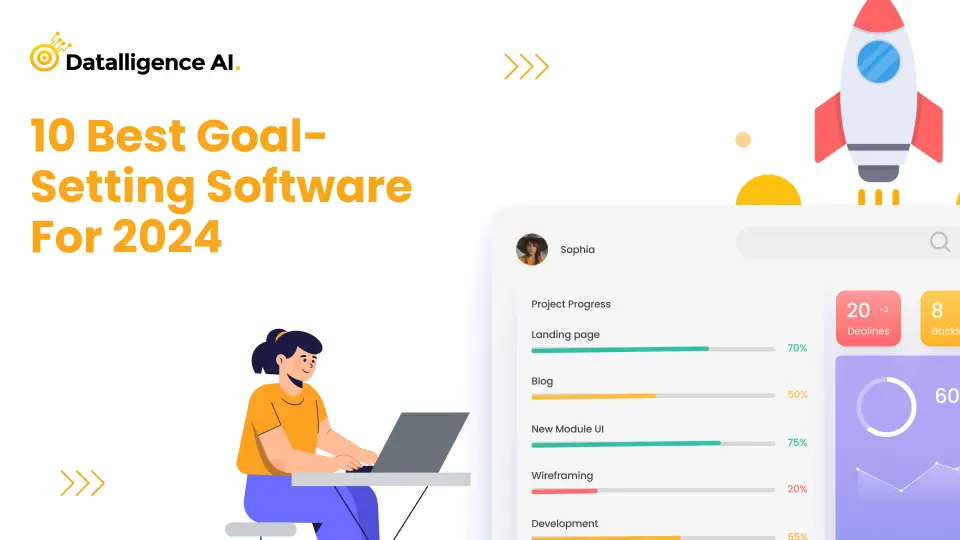Are you feeling a bit lost in the hustle and bustle of chasing your goals? Well, fear not! Documenting your goal progress is like having a roadmap to success. It’s time to dive into why documenting your goals matters, how often you should track your progress, and some handy tips on collecting evidence of your achievements along the way. Let’s make 2024 the year of clear direction and tangible results – let’s document our way to success together!
Why Documenting Goal Progress is Important
Ever feel like your goals are floating around in your mind, lacking clarity and direction? Documenting your goals gives them a solid foundation, making them more tangible and achievable. By putting pen to paper or typing it out, you’re taking the first step towards turning dreams into reality.
Moreover, documenting goals creates a sense of accountability. When you have a record of what you aim to accomplish, you’re more likely to stick with it and follow through. It’s like having a contract with yourself – you’ve committed to something concrete that’s now staring back at you from the page.
On top of that, documenting goals helps align individual objectives with those of the organization. When everyone is on the same page about what they’re working towards, teamwork becomes more cohesive and effective. So grab that notebook or fire up that goal-tracking app – let’s get those aspirations down on paper!
Clarity in Achieving Objectives
The process of documenting goals serves to clarify the objectives for all team members. It ensures that everyone understands what needs to be accomplished and provides a roadmap on how to achieve these goals. This clarity is essential as it helps individuals and teams stay focused on their tasks and priorities.
Documenting goals also allows for more objective assessment of progress, as stated by Robert Kaskel, chief people officer at Checkr, who emphasizes that having goals in black and white helps in understanding what’s going right and what needs improvement.
Creating Accountability
When goals are documented, accountability is naturally established among team members. Knowing what tasks need to be completed and having a clear understanding of one’s responsibilities increases an individual’s commitment to the role. Gates Little, president and CEO of The Southern Bank Company, highlights that a goal that isn’t documented is merely an idea. Thus, documenting goals not only fosters a sense of responsibility but also enhances focus and commitment to achieving these goals. Additionally, it allows for peer networks and managerial support to provide feedback that is crucial for ongoing improvement and success.
Aligning Employee and Organizational Objectives
https://www.instagram.com/p/C0t08hRu1g5/?img_index=1
Effective goal documentation aligns the objectives of individual employees with the broader organizational goals. This alignment is pivotal in ensuring that every team member’s efforts contribute positively to the company’s overall strategy. For instance, if a company aims to enhance its customer service reputation, managers and employees can set specific goals to achieve high customer satisfaction scores. This not only helps in personal achievement but also directly impacts the company’s success, creating a win-win situation for both employees and the organization.
In conclusion, documenting goal progress is not just about keeping track of what has been done. It is about setting a clear direction, creating accountability, and aligning individual efforts with the company’s strategic objectives. By embracing this practice, organizations like Datalligence can ensure that all team members are not only aware of their roles but are also actively engaged in driving the company towards its long-term goals.
How Often Should You Document Goal Progress?
Consistency is key when it comes to documenting goal progress. Regularly tracking and updating your goals ensures that you stay on the right path towards achieving them. Depending on the nature of your goals, consider setting aside time weekly or monthly to review and document your progress.
By establishing a routine for documenting goal progress, you create a habit that reinforces accountability and keeps you focused. This regular cadence allows for timely adjustments and course corrections as needed, helping you stay agile in pursuing your objectives.
Moreover, frequent documentation enables real-time monitoring of milestones achieved and challenges faced along the way. It provides valuable insights into what strategies are working well and where improvements may be necessary to propel towards success.
Consistently documenting goal progress not only keeps you organized but also enhances motivation by showcasing how far you’ve come since starting your journey.
Collecting Evidence of Progress Toward Your Goals
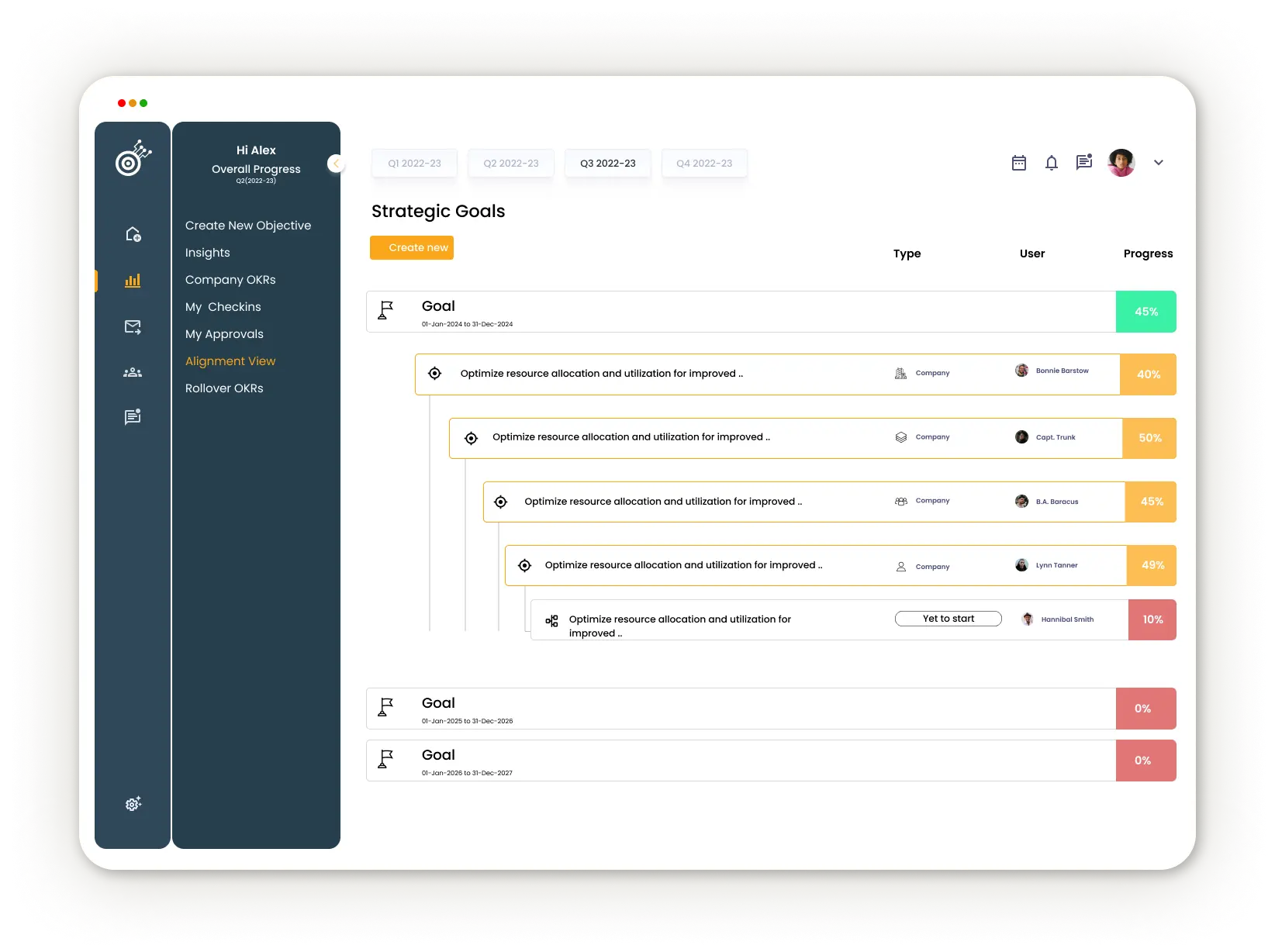
When it comes to tracking your progress towards your goals, collecting evidence is key. Start by setting clear metrics and milestones that will help you measure your advancement. This could include quantitative data like sales numbers or qualitative feedback from clients.
Utilize a variety of tools and methods to gather evidence of your progress. Keep detailed records, use project management software, track KPIs regularly, and schedule check-ins with team members for updates.
Don’t forget about self-reflection. Journaling your thoughts and feelings throughout the process can provide valuable insights into how you’re progressing towards your goals.
Stay adaptable and be willing to adjust your strategies based on the evidence you collect. Remember, documenting your progress isn’t just about proving success—it’s also about learning from setbacks and making improvements along the way.
How to Document Goal Progress
Documenting goal progress is crucial for staying on track and achieving success. To effectively document your goals, start by clearly defining them with specific and measurable objectives. Break down your goals into smaller tasks or milestones that can be easily tracked.
Utilize tools like spreadsheets, project management software, or specialized OKR platforms to monitor and update your progress regularly. Make sure to record any achievements, setbacks, or adjustments made along the way.
Consider creating visual representations such as charts or graphs to visually see how close you are to reaching your goals. Regularly review and reflect on your documented progress to identify areas of improvement or celebrate milestones achieved.
By documenting goal progress consistently and transparently, you not only hold yourself accountable but also have a clear roadmap towards accomplishing your objectives.
As you continue to document your goal progress, remember that consistency is key. Regularly review and update your documentation to track your achievements and adjust strategies as needed. By following these steps and incorporating examples of how others have successfully documented their progress, you can effectively showcase your accomplishments, stay motivated, and ultimately reach new heights in 2024. Keep documenting, keep progressing!
Here are some steps to follow for effectively documenting goal progress:
1. Define your goals: Clearly define your goals with specific and measurable objectives. This will help you track your progress and determine when you have achieved them.
2. Break down your goals: Breaking down larger goals into smaller tasks or milestones can make them more manageable and easier to track. This also allows for a sense of accomplishment as you complete each task towards your ultimate goal.
3. Choose a tracking method: Decide on a method for documenting your progress that works best for you. This could be using spreadsheets, project management software, or specialized OKR platforms.
4. Set timelines: Assign specific timelines to each milestone or task to keep yourself accountable and motivated to stay on track.
5. Record updates regularly: Make it a habit to regularly update your progress in your chosen tracking method. This could be daily, weekly, or monthly depending on the timeline of your goals.
6. Track achievements and setbacks: Record both achievements and setbacks in your progress documentation. This can help you identify patterns or areas that need improvement.
7. Make adjustments as needed: Goals may change over time due to various factors such as external circumstances or personal growth. Document any adjustments made to your goals so you
Examples of Effective Documentation
In the realm of goal setting and achievement, documenting progress is a pivotal aspect that can significantly impact the outcome. Two methodologies stand out in their effectiveness for tracking and realizing objectives: SMART Goals and Objectives and Key Results (OKRs). This section delves into examples of how these approaches have been employed successfully, illustrating their utility in various scenarios.
SMART Goals in Action
A comprehensive alignment view of company OKRs, illustrating how individual objectives contribute to overarching company goals with visual progress tracking. The hierarchical structure highlights the interconnectedness of goals. This alignment ensures everyone’s efforts are driving towards the same mission. Regularly reviewing this alignment boosts strategic coherence. Datalligence OKRs & Goals simplifies the alignment and tracking of organizational objectives.

The SMART framework is renowned for its clarity and specificity, making it a favored choice for individual and short-term objectives. An exemplary case of SMART goal implementation can be observed in a project aimed at enhancing customer experience through a mobile application. The goal was explicitly defined: “Launch a mobile app for the company website by the end of Q2, aiming for 50,000 installs within six months of launch and a 5% conversion rate.”
This goal encapsulates all elements of the SMART criteria—specific, measurable, achievable, relevant, and time-bound—providing a clear roadmap for the project team. Similarly, an individual seeking to improve their PowerPoint skills set a SMART goal to “Become proficient in PowerPoint to reduce its time consumption to 25% of the workload within six months.” By focusing on specific skills and setting a realistic timeline, the individual could measure progress and adjust their learning strategy as needed.
Utilizing OKRs
A personalized dashboard view that outlines goal progress, assigned users, and completion statuses, enabling efficient progress monitoring and management. The clear visuals help identify areas needing attention. Regular updates ensure everyone stays on the same page. This fosters a culture of transparency and continuous improvement. Datalligence OKRs & Goals enhances this with its intuitive tracking features.
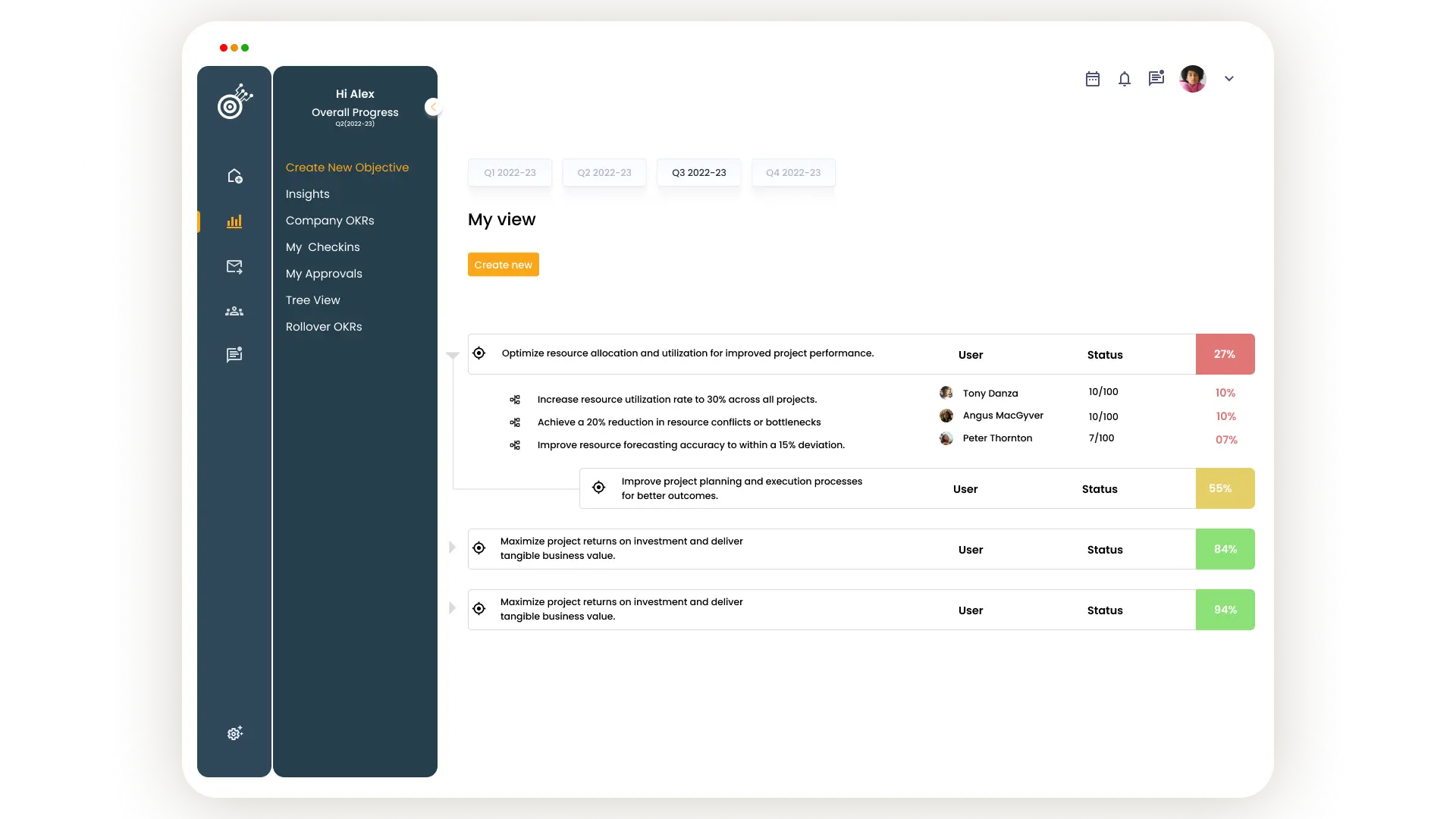
OKRs thrive on ambition and flexibility, making them ideal for scaling objectives and aligning them with broader organizational goals. A compelling example of OKR application is found within a company’s sustainability initiative. The objective was to “Design products and services for circularity and reuse materials at their highest environmental and social value.” The key results aimed for 100% inclusion of recycled materials in all products launched from 2022 onwards.
This OKR not only set a clear, ambitious goal but also provided measurable outcomes to track progress. Another instance is a professional soccer team’s aspiration to “Win the World Cup,” with key results focusing on average scored and conceded goals rates, as well as ball possession rate. Through these quantifiable metrics, the team could align individual and collective efforts towards the overarching objective.
Combining Both Approaches
An interactive dashboard displaying individual and team objectives with progress indicators and status updates for effective goal tracking. Users can easily monitor key results and check off completed tasks. The clean layout promotes clarity and focus on priorities. This helps teams stay aligned and accountable. Tools like Datalligence OKRs & Goals make this process seamless and efficient.
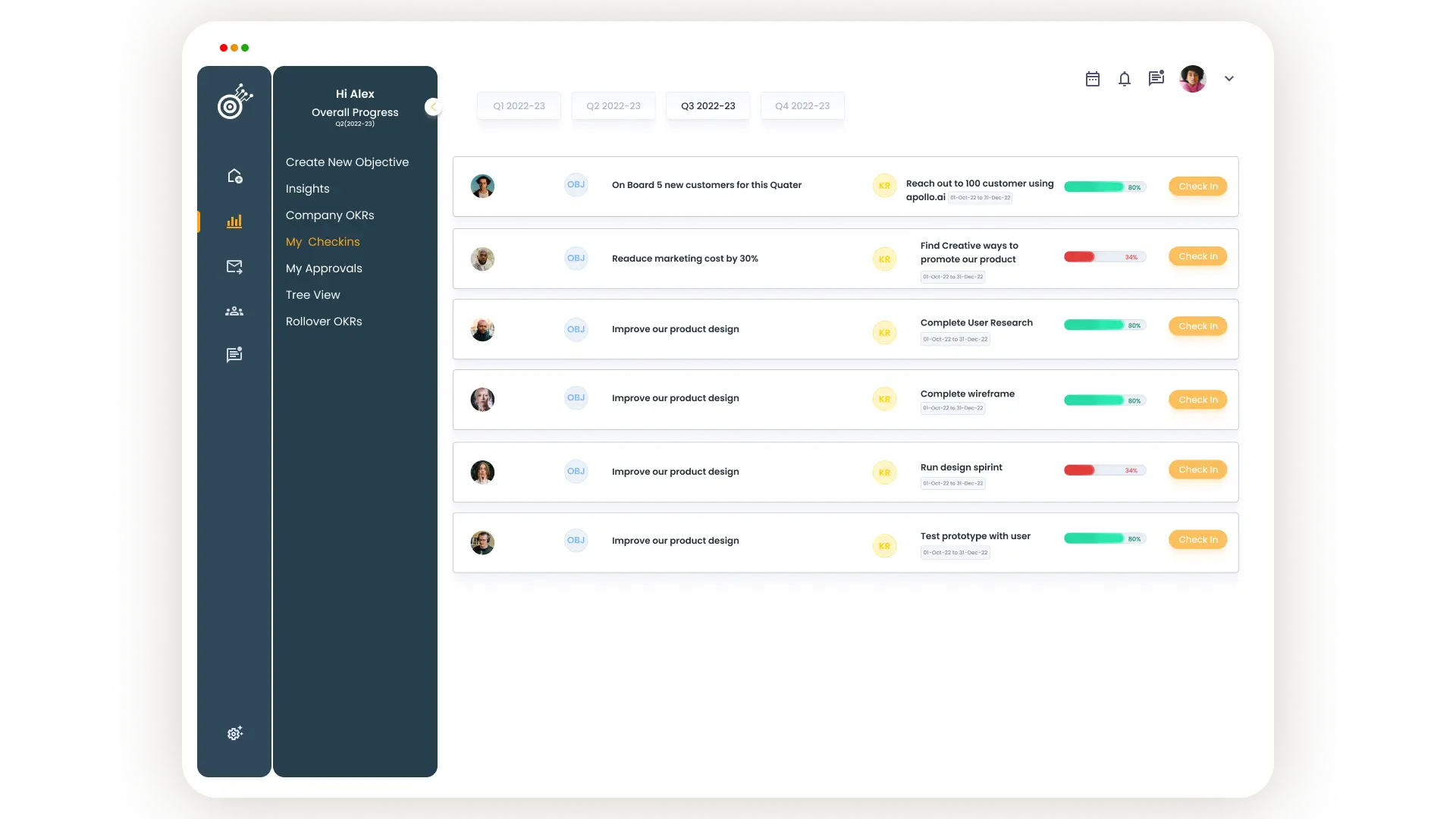
While SMART goals and OKRs serve distinct purposes, their integration can offer a comprehensive framework for goal documentation. For instance, an organization aiming for a 20% profit margin might utilize OKRs for the broad objective and SMART guidelines for the milestones, ensuring both ambition and specificit
This hybrid approach facilitates flexibility in strategic planning while maintaining clear, measurable steps towards the goal. It underscores the importance of setting ambitious targets (OKRs) while ensuring each step is clear and attainable (SMART).
In conclusion, effective documentation of goal progress through SMART goals and OKRs can significantly enhance the ability to achieve objectives. Whether through the clarity and specificity of SMART goals or the ambitious and flexible nature of OKRs, these methodologies provide valuable frameworks for individuals and organizations alike. By selecting the appropriate approach or combining both, one can create a robust system for tracking progress, aligning efforts, and ultimately realizing goals.
Common Challenges and How to Overcome Them
In the journey toward achieving goals, individuals and organizations often encounter a variety of challenges that can impede progress. These challenges, if not addressed properly, can derail the entire goal-setting and achievement process. Below, we explore three common challenges: time management, maintaining consistency, and dealing with incomplete data, along with strategies to overcome them.
Time Management
Effective time management is crucial for success in any endeavor. However, it is often plagued by procrastination, distractions, and a lack of motivation. To overcome these challenges, it is essential to identify the root causes of time wastage within your organization. Implementing technology that aids in managing time more efficiently can be a game-changer.
For instance, tools that automate repetitive tasks can free up valuable time, allowing employees to focus on more strategic activities. Additionally, fostering a culture that values breaks and understands the importance of recharging can enhance focus and productivity. Encouraging employees to prioritize tasks and eliminate multitasking can also lead to more effective time management.
Maintaining Consistency
Consistency is the backbone of progress towards achieving goals. The “all or nothing” mentality and casual commitments often lead to inconsistency, which can be detrimental to goal achievement. To combat this, setting realistic, achievable goals and breaking them down into smaller, manageable tasks can help maintain momentum. It’s also beneficial to plan ahead and establish routines that support consistent action towards goals. Utilizing habit stacking and having accountability partners can further reinforce consistency. Moreover, developing a backup plan for when disruptions occur ensures that progress continues, albeit at a modified pace.
Dealing with Incomplete Data
Incomplete data presents a significant challenge in data management and analysis, impacting the accuracy and reliability of insights derived. The first step in addressing this issue is to identify the type and extent of missing data, categorized as missing completely at random (MCAR), missing at random (MAR), or missing not at random (MNAR). Depending on the type, various strategies such as deletion, imputation, or model-based methods can be employed.
For instance, simple techniques like mean/median/mode imputation for numerical or categorical features, respectively, can address missing values. More sophisticated approaches like regression imputation, K-Nearest Neighbours (KNN) imputation, or Multivariate Imputation by Chained Equations (MICE) offer solutions for more complex missing data patterns. Regardless of the method chosen, it is crucial to validate and document the process to ensure consistency and reliability in data analysis.
By addressing these common challenges with strategic approaches, individuals and organizations can enhance their ability to achieve goals effectively. Whether it’s through better time management, maintaining consistency, or dealing with incomplete data, the key lies in identifying the challenges and implementing targeted strategies to overcome them.
Datalligence OKRs & Goals makes documentation easier.
Documenting goal progress is essential for personal and professional growth. By having a clear record of your goals, you can track your achievements, stay accountable, and align your efforts with organizational objectives. With the right tools like Datalligence OKRs & Goals, documenting progress becomes easier and more efficient. So start documenting your goals today to unlock the full potential of your ambitions and make 2024 a year of significant progress and success!
When it comes to achieving your goals and documenting your progress, having the right tools can make all the difference. Datalligence OKRs & Goals is a powerful solution that streamlines the process of tracking and documenting goal progress. By utilizing this platform, you can easily monitor your objectives, track key results, and document milestones along the way.
With features designed to enhance visibility, collaboration, and accountability, Datalligence OKRs & Goals empowers individuals and teams to document their progress effectively. Whether you are a business leader striving for organizational success or an individual aiming for personal growth, this tool provides a structured framework for setting goals, monitoring progress, and celebrating achievements.
Incorporating Datalligence into your goal documentation strategy not only simplifies the process but also fosters a culture of transparency and alignment within your organization. By harnessing the power of technology to document goal progress efficiently, you set yourself up for greater clarity, accountability, and success in 2024 and beyond. Elevate your goal-setting journey with Datalligence OKRs & Goals today!
Documenting goal progress is a crucial aspect of achieving success, both individually and within organizations. By documenting goals, you gain clarity, create accountability, and ensure alignment between employee and organizational objectives. It allows for tracking progress effectively and making necessary adjustments along the way.
When it comes to documenting goal progress, consistency is key. Regularly updating your progress ensures that you stay on track and can identify any challenges early on. Utilizing tools like Datalligence OKRs & Goals can streamline the documentation process, making it easier to collect evidence of your progress towards your goals.
So, whether you are an individual striving to achieve personal milestones or a team working towards organizational targets, documenting goal progress is essential for success. Start today by outlining your goals, tracking your progress diligently, and utilizing tools that make documentation more manageable. With these practices in place, you’ll be well on your way to turning your aspirations into achievements!

